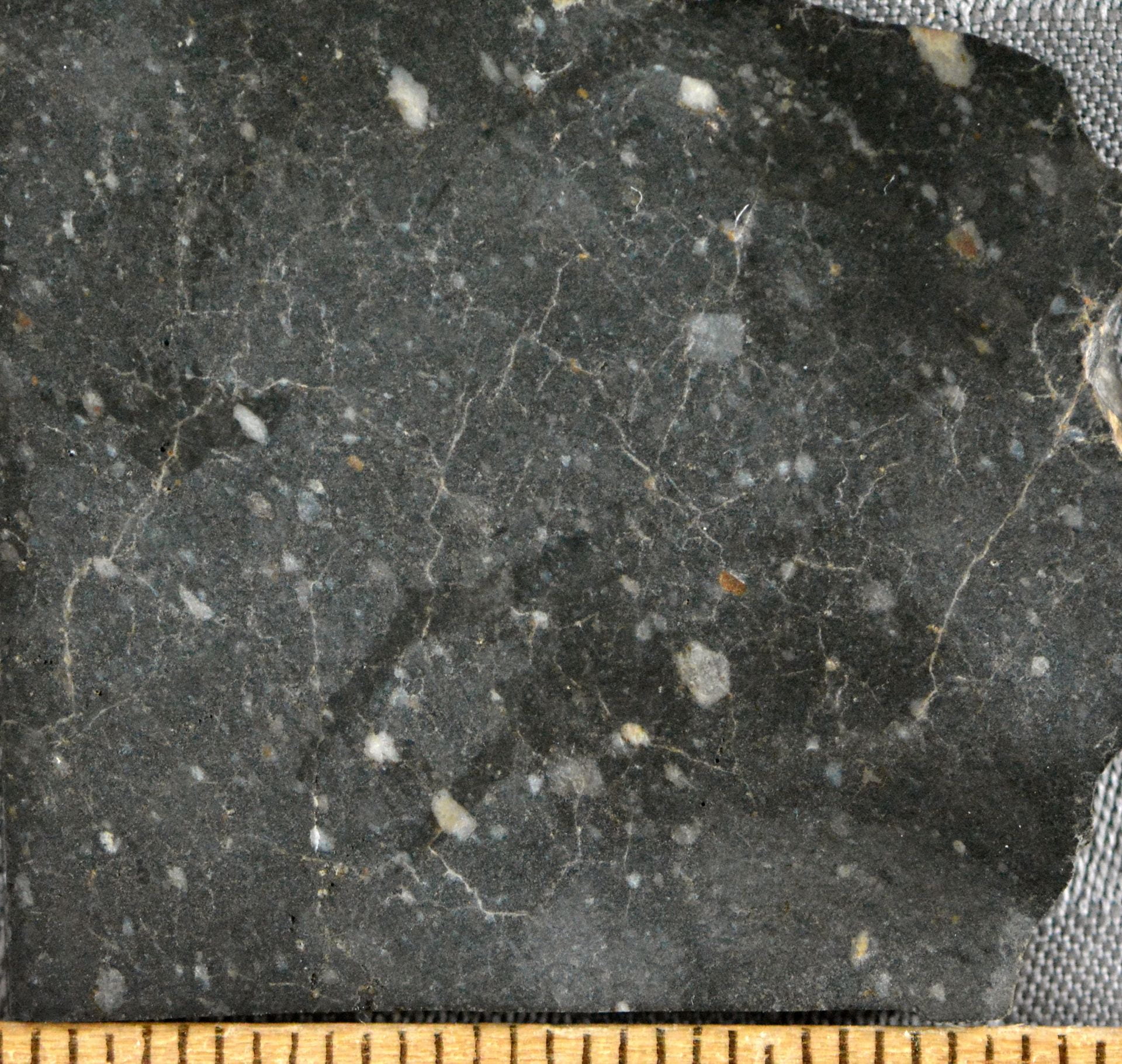Lunar Meteorite: Northwest Africa 12604



|
from The Meteoritical Bulletin, No. 108 Northwest Africa 12604 (NWA 12604)(Northwestern Africa) Lunar meteorite (feldspathic breccia) History: Purchased 29 Oct 2017 at the Munich show from Aziz Habibi. According to Mr. Habibi the meteorite was unpaired. Physical characteristics: A slice with a thickness of 2 mm was available. The interior of the sample appears fresh, the surface partly wind ablated and shiny – in part the minerals and clast are visible on the surface. No unequivocal fusion crust, on one side a fine layer of attached desert sand. Petrography: Macroscopic: The cut surface of the interior appears black and dark gray, with well visible white clasts of plagioclase. Mafic minerals appear grey and black and are not easily discerned from the dark matrix. Many very fine white veins transect the sample. Microscopic. Complex and polyphase breccia with different generations of impact melts and fine grained matrices. More than 50% of the thin section appear black in polarized transmitted light and are thus interpreted as glass. On the EMPA different degree of devitrification and extremely fine (re?)crystallisation are visible in such glasses. The largest rock- or mineral-clasts are approx. 3 mm, the smallest grains <1 μm. Larger glass shards with included rock and mineral fragments up to 1 cm account for about 50% of the bulk, but glass is also frequent in the rest of the sample. A weak planar arrangement is visible, interpreted as a irregular layering due to fall out of impact material. Glass beads and agglutinates are present, indicative for lunar regolith. The main fraction of the sample stems from a feldspathic moon area (ANT-Suite, gabbro clast) but also basalt clasts (even mare type) are observed as minor components. A fraction of the plagioclase grains and clasts are completely transformed to maskelynite. Other grains show complex fracturing, fine grained recrystallisation and irregular extinction. Pyroxene frequently show undulous or patchy extinction. Additional observed phases are ilmenite, chrome-spinel and Fe-Ni metal. Terrestrial calcite fills veins and vesicles in agglutinates. Geochemistry: Composition of Ca-poor pyroxene (pigeonite or othopyroxene) (n=42): Fs27.30±10.56Wo7.29±4.77 (range Fs12.73-78.07Wo2.61-19.94); Fe/Mg = 0.42, Fe/Mn 54.42 (one exceptionally Mg-rich point excluded from ratios). Composition of Ca-rich pyroxene (clinopyroxene) (n=15): Fs31.00±19.24Wo29.65±6.85 (range Fs8.54-59.58Wo20.56-38.36); Fe/Mg = 1.40, Fe/Mn 50.35. Olivine composition (n=27): Fa30.54±9.71 (range Fa19.25-60.92); Fe/Mg = 0.48, Fe/Mn 88.78. Plagioclase composition (n=73): An95.80±1.20Or0.34±0.24 (range An90.71-97.74Or0.01-1.28). Melt compositions vary strongly with xSi 29.7-46.5, xCa 9.9-17.6, xFe 3.8-16.3, xMg 7.5-21.1 and xTi 0.0-3.2. Fe/Mn ratios of silicate minerals are within the range of observed compositions for the moon but on the lower end of the range with single ratios as low as 33. Bulk analysis of cut surface by pXRF (wt%): Fe/Mg = 1.5±0.1, Fe/Mn 84.2±8.8 (n=10), Fe = 4.6 wt.% (n=10). Classification: (T. Burri and B. Hofmann, Natural History Museum Bern) This meteorite is a mixed but mainly feldspathic glass-rich lunar regolith breccia, rich in glass and fragments with impact melts. Mineral compositions as well as Fe/Mg and Fe/Mn ratios of minerals and bulk Fe/Mn are proof for a lunar origin of the sample. Specimens: A total of 21.7 g and one polished section at NMBE; Main mass with Marc Jost. |
|
Randy Says… Northwest Africa 12604 is a lunar meteorite of noritic anorthosite composition. |
More InformationMeteoritical Bulletin Database NWA 12604 References Korotev R. L. and Irving A. J. (2021) Lunar meteorites from northern Africa. Meteoritics & Planetary Science, 206–240. |